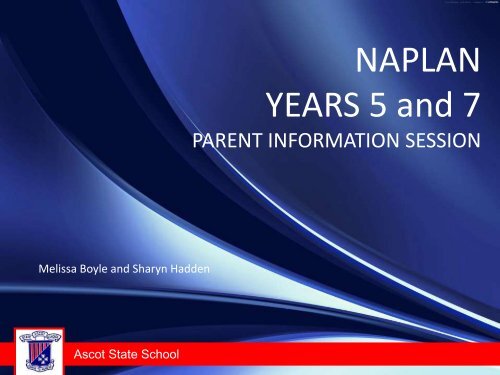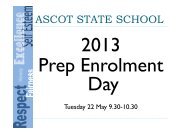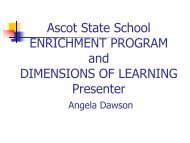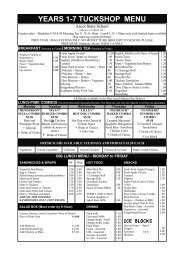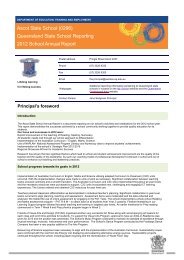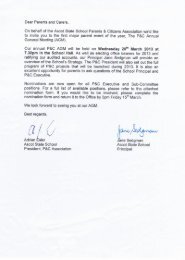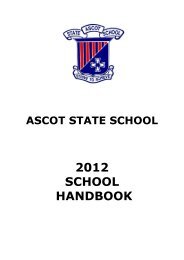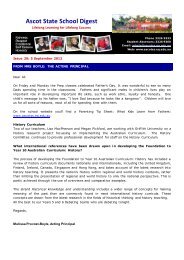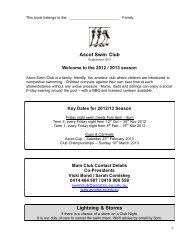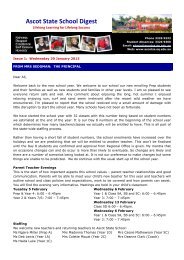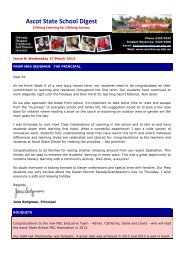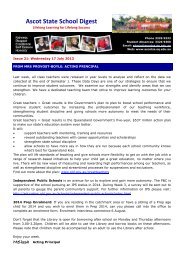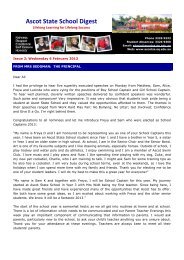Years 5 and 7 NAPLAN PARENT INFORMATION SESSION
Years 5 and 7 NAPLAN PARENT INFORMATION SESSION
Years 5 and 7 NAPLAN PARENT INFORMATION SESSION
Create successful ePaper yourself
Turn your PDF publications into a flip-book with our unique Google optimized e-Paper software.
<strong>NAPLAN</strong><br />
YEARS 5 <strong>and</strong> 7<br />
<strong>PARENT</strong> <strong>INFORMATION</strong> <strong>SESSION</strong><br />
Melissa Boyle <strong>and</strong> Sharyn Hadden<br />
Ascot State School
What is <strong>NAPLAN</strong>?<br />
The National Assessment Program – Literacy <strong>and</strong><br />
Numeracy (<strong>NAPLAN</strong>) is an annual national assessment for all students in <strong>Years</strong><br />
3, 5, 7, <strong>and</strong> 9.<br />
All students in these year levels are expected to participate in tests in<br />
Reading, Writing, Language Conventions (spelling, grammar <strong>and</strong> punctuation)<br />
<strong>and</strong> Numeracy.<br />
Purpose of the Tests<br />
The <strong>NAPLAN</strong> tests are designed to assess the skills of Australian students in<br />
literacy <strong>and</strong> numeracy. The specific purposes are:<br />
• to collect data from the population of <strong>Years</strong> 3, 5, 7 <strong>and</strong> 9 students for<br />
reporting to parents/carers <strong>and</strong> schools for systematic reporting<br />
• to accommodate the assessment of students against national minimum<br />
st<strong>and</strong>ards.<br />
• To provide schools, states <strong>and</strong> territories with information about how<br />
education programs are working <strong>and</strong> which areas need to be prioritised<br />
for improvement.
How are <strong>NAPLAN</strong> results used?<br />
• Schools use results to identify strengths <strong>and</strong> weaknesses in<br />
teaching programs <strong>and</strong> to set goals in literacy <strong>and</strong> numeracy.<br />
• School systems use results to review programs <strong>and</strong> support<br />
offered to schools.<br />
• Students <strong>and</strong> parents may use individual results to discuss<br />
progress with teachers.<br />
• Teachers use results to help them better identify students<br />
who require greater challenges or additional support.<br />
• The community can see average school <strong>NAPLAN</strong> results on the<br />
My School website.
What is Tested?<br />
A series of tests will assess areas of literacy <strong>and</strong> numeracy.<br />
The following areas of literacy are assessed:<br />
• Language conventions - spelling, grammar <strong>and</strong> punctuation<br />
• Writing - knowledge <strong>and</strong> control of written language<br />
• Reading - comprehension.<br />
As in other years, students in <strong>Years</strong> 3, 5, 7 <strong>and</strong> 9 will be required to respond to a stimulus in the<br />
2013 <strong>NAPLAN</strong> Writing test. Students are asked to write a response to the task in a maximum of<br />
three pages.<br />
The response formats for questions on all other test papers will be either multiple choice (shade<br />
a bubble to indicate the answer) or constructed response (write the answer in a box or on a line).<br />
In numeracy, the content areas assessed are:<br />
• Number<br />
• Measurement, chance <strong>and</strong> data<br />
• Space<br />
• Algebra, function <strong>and</strong> pattern (formal algebra for Year 9 only).
Assessment <strong>and</strong> Reporting<br />
Results from the tests will provide important<br />
information about children's progress in literacy <strong>and</strong><br />
numeracy. Following the tests, schools <strong>and</strong> students<br />
will receive a statement of performance in relation to<br />
the national minimum st<strong>and</strong>ards.<br />
<strong>NAPLAN</strong> tests are one aspect of the school’s<br />
assessment <strong>and</strong> reporting process, <strong>and</strong> do not replace<br />
the extensive, ongoing assessments made by teachers<br />
about each student’s performance.
Time of Testing<br />
Tuesday 14 May<br />
Official test date<br />
Wednesday 15 May<br />
Official test date<br />
Thursday 16 May<br />
Official test date<br />
Friday 17 May<br />
Catch up tests<br />
permitted<br />
Language conventions<br />
Yr 3: 40 min<br />
Yr 5: 40 min<br />
Yr 7: 45 min<br />
Reading<br />
Yr 3: 45 min<br />
Yr 5: 50 min<br />
Yr 7: 65 min<br />
Numeracy<br />
Yr 3: 45 min<br />
Yr 5: 50 min<br />
Yr 7 (calculator): 40 min<br />
Yr 7 (non-calc.): 40 min<br />
Writing<br />
Yr 3: 40 min<br />
Yr 5: 40 min<br />
Yr 7: 40 min
Writing – Persuasive Text<br />
Writing: students write a persuasive text in response to a given<br />
stimulus. They are assessed on the quality <strong>and</strong> organisation of<br />
ideas, structuring of sentences <strong>and</strong> use of correct spelling <strong>and</strong><br />
punctuation.
Language Conventions<br />
Language Conventions: students<br />
identify <strong>and</strong> correct spelling errors <strong>and</strong><br />
answer questions on aspects of<br />
grammar <strong>and</strong> punctuation.
Spelling – Year 5
Spelling – Year 7
Grammar <strong>and</strong> Punctuation – Year 5
Grammar <strong>and</strong> Punctuation – Year 7
Reading: students read a number of short texts <strong>and</strong><br />
answer questions to show underst<strong>and</strong>ing of the texts.<br />
Year 5
Reading: students read a number of short texts <strong>and</strong><br />
answer questions to show underst<strong>and</strong>ing of the texts.<br />
Year 7
Numeracy: students solve problems across Number; Algebra, function<br />
<strong>and</strong> pattern; Measurement, chance <strong>and</strong> data; <strong>and</strong> Space.
Numeracy: students solve problems across Number; Algebra, function<br />
<strong>and</strong> pattern; Measurement, chance <strong>and</strong> data; <strong>and</strong> Space.
How is the school preparing my<br />
child for <strong>NAPLAN</strong>?<br />
• We are preparing students for <strong>NAPLAN</strong> at school<br />
through good quality teaching.<br />
• Children are engaged in Test Wiseness activities at<br />
school each day. The aim of these activities is for<br />
students to be familiar with test instructions <strong>and</strong><br />
common forms of questions.<br />
• Adequate preparation ensures that students feel<br />
comfortable in the testing environment <strong>and</strong> are able<br />
to confidently demonstrate what they know <strong>and</strong> can<br />
do.
How can I help my child prepare<br />
for <strong>NAPLAN</strong>?<br />
• Focus on doing their best & trying hard<br />
• Validate your child’s feelings if they’re feeling nervous, tell them that it’s<br />
normal to feel a little nervous. Listen to any of their concerns.<br />
• Give them some relaxation ideas: deep breaths.<br />
• Give them a good breakfast on each of the assessment days.<br />
• Be positive when asking your child how the test went. If you act worried,<br />
your anxiety will be noticed.<br />
• Treat the test as just one component of your child’s educational<br />
achievements.<br />
• Make sure your child’s sleeping <strong>and</strong> waking schedule is regular in the days<br />
leading up to <strong>and</strong> during the assessment period.<br />
Above all have a positive view of <strong>NAPLAN</strong> – a positive<br />
caring attitude is the best thing you can do to support<br />
your child.
Where can I get more information?<br />
For more information about <strong>NAPLAN</strong>:<br />
• visit National Assessment Program<br />
www.nap.edu.au<br />
• visit QSA www.qsa.qld.edu.au<br />
A parent information tip sheet will be on the<br />
school website this week:<br />
http://ascotss.eq.edu.au/wcms/


